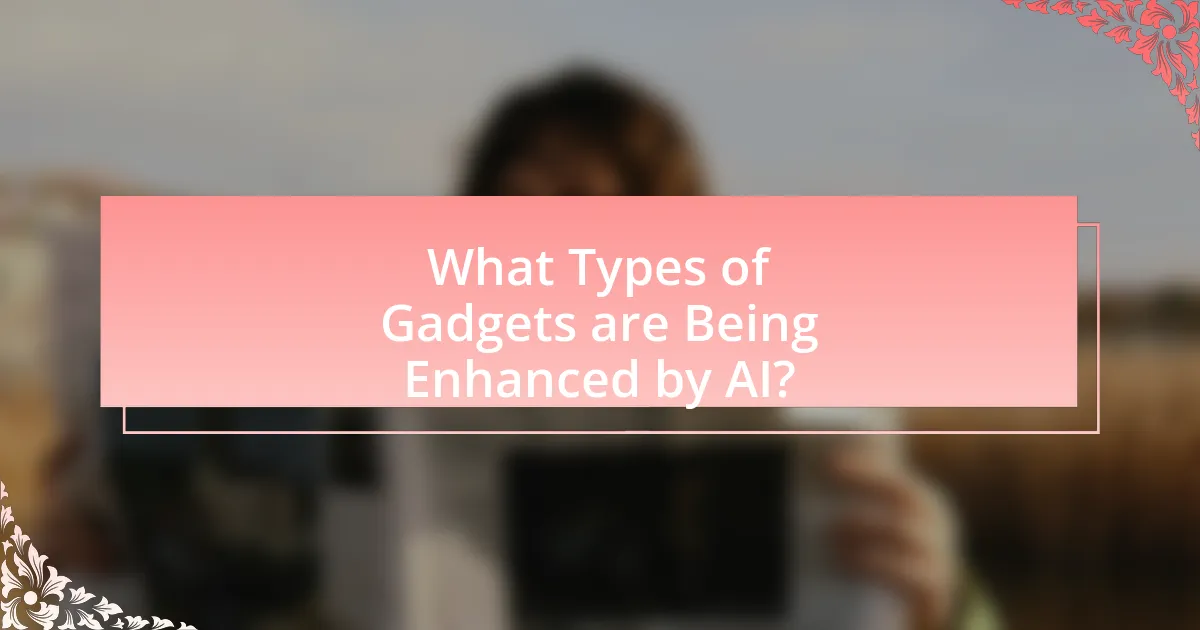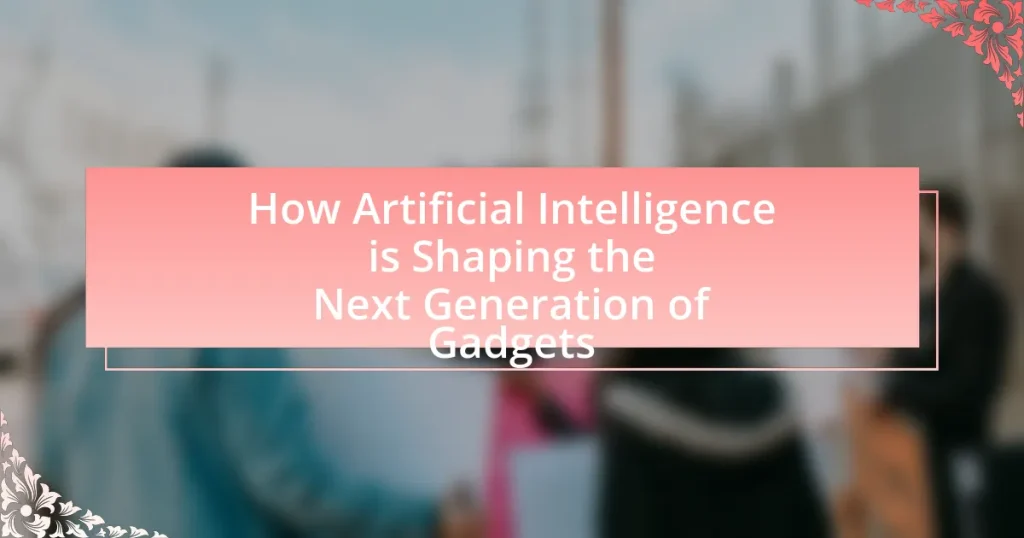Artificial Intelligence (AI) is significantly transforming the functionality and user interaction of modern gadgets, including smart home devices, smartphones, wearables, and drones. Key advancements in AI technology, such as enhanced machine learning algorithms and natural language processing, are driving this evolution, enabling personalized experiences and improved efficiency. The integration of AI in gadgets not only optimizes performance and energy consumption but also enhances user experience through intuitive interfaces and automation. However, challenges such as data privacy concerns and technical limitations remain critical issues in the development of AI-driven devices. The article explores these advancements, implications, and future trends in AI technology as it shapes the next generation of consumer electronics.

How is Artificial Intelligence Transforming Gadgets?
Artificial Intelligence is transforming gadgets by enhancing their functionality, personalization, and user interaction. For instance, smart home devices like thermostats and security cameras utilize AI algorithms to learn user preferences and optimize energy usage or improve security measures. According to a report by Statista, the global smart home market is projected to reach $174 billion by 2025, driven largely by AI integration. Additionally, AI-powered voice assistants, such as Amazon’s Alexa and Google Assistant, enable hands-free control and seamless integration with various devices, making everyday tasks more efficient. This evolution in gadget capabilities demonstrates how AI is fundamentally reshaping user experiences and device performance.
What are the key advancements in AI technology impacting gadgets?
Key advancements in AI technology impacting gadgets include enhanced machine learning algorithms, improved natural language processing, and advanced computer vision capabilities. Enhanced machine learning algorithms enable gadgets to learn from user behavior, leading to personalized experiences and increased efficiency. Improved natural language processing allows for more intuitive voice recognition and interaction, making devices like smart speakers and virtual assistants more user-friendly. Advanced computer vision capabilities facilitate features such as facial recognition and object detection, which enhance security and usability in devices like smartphones and smart cameras. These advancements are supported by significant investments in AI research and development, with the global AI market projected to reach $390 billion by 2025, indicating a strong trend towards integrating AI into consumer gadgets.
How do machine learning algorithms enhance gadget functionality?
Machine learning algorithms enhance gadget functionality by enabling devices to learn from user interactions and adapt their performance accordingly. For instance, smart home devices utilize machine learning to analyze usage patterns, allowing them to optimize energy consumption and improve user comfort. A study by Google Research demonstrated that machine learning can increase the efficiency of smart thermostats by up to 15% through predictive analytics, which adjusts heating and cooling based on user behavior. This adaptability not only improves user experience but also contributes to energy savings and operational efficiency in gadgets.
What role does natural language processing play in user interaction?
Natural language processing (NLP) facilitates user interaction by enabling machines to understand, interpret, and respond to human language in a meaningful way. This capability enhances communication between users and devices, allowing for more intuitive interfaces such as voice-activated assistants and chatbots. For instance, according to a report by Gartner, by 2022, 70% of interactions with technology were expected to be through conversational interfaces, demonstrating the growing reliance on NLP for effective user engagement.
Why is AI integration crucial for the next generation of gadgets?
AI integration is crucial for the next generation of gadgets because it enhances functionality, personalization, and efficiency. By incorporating AI, devices can process vast amounts of data in real-time, enabling features such as voice recognition, predictive analytics, and automated responses. For instance, smart home devices utilize AI to learn user preferences, optimizing energy consumption and improving user experience. According to a report by McKinsey, AI could potentially create an additional $13 trillion in global economic activity by 2030, underscoring its transformative impact on technology and consumer products.
How does AI improve user experience and personalization?
AI enhances user experience and personalization by analyzing user data to tailor interactions and recommendations. For instance, machine learning algorithms can process vast amounts of data from user behavior, preferences, and feedback to create customized content and product suggestions. According to a report by McKinsey, companies that leverage AI for personalization can achieve a 10-30% increase in revenue, demonstrating the effectiveness of AI in creating more relevant and engaging user experiences.
What are the implications of AI on gadget performance and efficiency?
AI significantly enhances gadget performance and efficiency by optimizing resource management and enabling intelligent automation. For instance, AI algorithms can analyze user behavior to adjust power consumption dynamically, leading to longer battery life in devices such as smartphones and laptops. Research from the International Journal of Computer Applications indicates that AI-driven optimization can improve processing speeds by up to 30% in various applications, demonstrating a clear correlation between AI integration and enhanced gadget functionality. Additionally, AI can facilitate predictive maintenance, reducing downtime and improving overall efficiency in devices by anticipating failures before they occur.
What challenges does AI face in gadget development?
AI faces several challenges in gadget development, including limited processing power, data privacy concerns, and the need for robust algorithms. Limited processing power restricts the complexity of AI models that can be deployed in gadgets, impacting their performance and capabilities. Data privacy concerns arise as AI systems often require large amounts of personal data to function effectively, leading to potential breaches of user trust and regulatory compliance issues. Additionally, the need for robust algorithms is critical, as many existing models struggle with real-time decision-making and adaptability in dynamic environments. These challenges hinder the full integration of AI into next-generation gadgets, affecting their functionality and user acceptance.
How do privacy concerns affect AI implementation in gadgets?
Privacy concerns significantly hinder AI implementation in gadgets by limiting data collection and usage. As consumers become increasingly aware of data privacy issues, manufacturers face pressure to ensure that personal information is protected, which can restrict the types of data AI systems can access. For instance, a survey by Pew Research Center found that 79% of Americans are concerned about how their data is used by companies, leading to stricter regulations like the General Data Protection Regulation (GDPR) in Europe. These regulations require explicit consent for data collection, which can complicate the development of AI features that rely on large datasets for training and functionality. Consequently, companies may opt for less sophisticated AI solutions that do not require extensive data, ultimately affecting the performance and capabilities of gadgets.
What are the technical limitations of current AI technologies?
Current AI technologies face several technical limitations, including a lack of generalization, data dependency, and interpretability issues. These limitations hinder AI systems from effectively applying learned knowledge to new, unseen situations, as they often require vast amounts of labeled data to perform well. For instance, AI models like deep learning networks excel in specific tasks but struggle to adapt to different contexts without retraining. Additionally, many AI systems operate as “black boxes,” making it difficult for users to understand how decisions are made, which raises concerns about trust and accountability. These challenges are documented in research such as “The Limitations of Deep Learning in Real-World Applications” by Yann LeCun, which highlights the necessity for improved methodologies to enhance AI’s applicability and reliability.

What Types of Gadgets are Being Enhanced by AI?
Smartphones, smart home devices, wearables, and drones are the primary types of gadgets being enhanced by AI. Smartphones utilize AI for features like camera optimization, voice assistants, and predictive text. Smart home devices, such as thermostats and security systems, leverage AI for automation and energy efficiency. Wearables, including fitness trackers and smartwatches, employ AI to analyze health data and provide personalized insights. Drones enhance navigation and obstacle avoidance through AI algorithms, improving their functionality and safety. These advancements demonstrate how AI is integral to the evolution of modern gadgets, making them more intelligent and user-friendly.
How are smart home devices evolving with AI?
Smart home devices are evolving with AI by integrating advanced machine learning algorithms that enhance their functionality and user experience. These devices now utilize AI to learn user preferences, automate tasks, and improve energy efficiency. For instance, smart thermostats like the Nest Learning Thermostat adapt to users’ schedules and preferences, resulting in energy savings of up to 15% according to the U.S. Department of Energy. Additionally, AI-powered voice assistants, such as Amazon Alexa and Google Assistant, enable seamless control of various smart home devices through natural language processing, making interactions more intuitive. This evolution signifies a shift towards more autonomous and responsive home environments, driven by AI advancements.
What features make AI-enabled smart speakers stand out?
AI-enabled smart speakers stand out due to their advanced voice recognition, natural language processing, and integration with smart home devices. These features allow users to interact with the speaker using conversational language, making it easier to perform tasks such as playing music, setting reminders, or controlling home appliances. For instance, the voice recognition technology can accurately identify different accents and dialects, enhancing user experience. Additionally, the integration capability enables seamless communication with various smart devices, creating a cohesive smart home ecosystem. According to a report by Statista, the global smart speaker market is projected to reach 35 million units by 2025, highlighting the growing reliance on these features in everyday life.
How does AI contribute to home security systems?
AI enhances home security systems by enabling advanced features such as real-time monitoring, facial recognition, and predictive analytics. These capabilities allow systems to identify potential threats more accurately and respond promptly. For instance, AI algorithms can analyze video feeds to distinguish between normal activity and suspicious behavior, reducing false alarms and improving response times. According to a report by MarketsandMarkets, the global AI in the security market is projected to grow from $3.5 billion in 2020 to $34.8 billion by 2026, highlighting the increasing reliance on AI technologies in enhancing security measures.
What advancements are seen in wearable technology due to AI?
Advancements in wearable technology due to AI include enhanced health monitoring, personalized user experiences, and improved data analytics. AI algorithms enable wearables to track vital signs like heart rate and sleep patterns with greater accuracy, allowing for real-time health insights. For instance, devices like the Apple Watch utilize machine learning to detect irregular heart rhythms, which can lead to early diagnosis of conditions such as atrial fibrillation. Additionally, AI-driven features in wearables can adapt to user behavior, providing tailored recommendations for fitness and wellness, thereby increasing user engagement and effectiveness. These advancements demonstrate how AI is transforming wearables into more intelligent and responsive health management tools.
How does AI improve health monitoring in wearables?
AI enhances health monitoring in wearables by enabling real-time data analysis and personalized health insights. Through machine learning algorithms, wearables can process vast amounts of biometric data, such as heart rate, sleep patterns, and activity levels, to detect anomalies and predict health issues. For instance, a study published in the journal “Nature” demonstrated that AI algorithms could accurately predict cardiovascular events by analyzing data from wearable devices, achieving a sensitivity of 85% and specificity of 90%. This capability allows users to receive timely alerts and recommendations, ultimately improving health outcomes and preventive care.
What role does AI play in fitness tracking devices?
AI plays a crucial role in fitness tracking devices by enabling advanced data analysis and personalized insights for users. These devices utilize AI algorithms to process vast amounts of biometric data, such as heart rate, activity levels, and sleep patterns, allowing for real-time feedback and tailored fitness recommendations. For instance, AI can identify trends in a user’s activity and suggest specific workouts or recovery strategies based on individual performance metrics. This capability enhances user engagement and promotes healthier lifestyle choices, as evidenced by studies showing that personalized fitness recommendations can lead to improved adherence to exercise regimens.
How is AI influencing mobile technology?
AI is significantly influencing mobile technology by enhancing user experiences through personalization and automation. For instance, AI algorithms analyze user behavior to provide tailored app recommendations and optimize device performance. According to a report by Gartner, AI-driven features in mobile devices are expected to improve user engagement by 30% by 2025. Additionally, AI-powered virtual assistants, such as Siri and Google Assistant, streamline tasks and improve accessibility, making mobile technology more intuitive and user-friendly.
What are the benefits of AI in smartphone cameras?
AI in smartphone cameras enhances image quality, optimizes settings, and enables advanced features like portrait mode and night photography. By utilizing machine learning algorithms, AI can analyze scenes and automatically adjust parameters such as exposure, focus, and color balance, resulting in clearer and more vibrant images. For instance, AI-driven computational photography techniques can combine multiple exposures to create a single high-dynamic-range image, significantly improving low-light performance. Additionally, AI can recognize subjects and scenes, applying specific enhancements tailored to the content, which has been shown to increase user satisfaction with photo outcomes.
How does AI enhance mobile app functionalities?
AI enhances mobile app functionalities by enabling personalized user experiences, improving automation, and facilitating advanced data analysis. For instance, AI algorithms analyze user behavior to tailor content and recommendations, leading to increased user engagement. Additionally, AI-powered chatbots automate customer support, providing instant responses and reducing wait times. Furthermore, AI enhances data analysis capabilities, allowing apps to process large datasets for insights, which can inform decision-making and improve app performance. These functionalities are supported by studies showing that personalized experiences can increase user retention by up to 30%, demonstrating the significant impact of AI on mobile applications.

What Future Trends Can We Expect in AI-Driven Gadgets?
Future trends in AI-driven gadgets include increased personalization, enhanced automation, and improved interoperability. Personalization will allow devices to adapt to individual user preferences through machine learning algorithms, making interactions more intuitive. Enhanced automation will enable gadgets to perform complex tasks autonomously, reducing the need for user intervention. Improved interoperability will facilitate seamless communication between devices, creating a more integrated smart ecosystem. According to a report by Gartner, by 2025, over 75% of consumer electronics will incorporate AI capabilities, underscoring the rapid evolution of AI in gadgets.
How will AI shape the design of future gadgets?
AI will significantly shape the design of future gadgets by enabling personalized user experiences and optimizing functionality. Through machine learning algorithms, gadgets will analyze user behavior and preferences, allowing for tailored interfaces and features that adapt to individual needs. For instance, smart home devices can learn routines and adjust settings automatically, enhancing convenience and energy efficiency. Additionally, AI-driven design tools can streamline the development process, allowing engineers to simulate and test various configurations rapidly, leading to innovative designs that are both user-friendly and efficient. This integration of AI in design processes is supported by studies showing that companies utilizing AI in product development can reduce time-to-market by up to 30%.
What innovations are on the horizon for AI in consumer electronics?
Innovations on the horizon for AI in consumer electronics include advanced personalization, enhanced voice recognition, and improved energy efficiency. Advanced personalization will allow devices to learn user preferences and behaviors, tailoring experiences to individual needs, as seen in smart home systems that adapt to user routines. Enhanced voice recognition technology is expected to become more accurate and context-aware, enabling seamless interaction with devices, which is already evident in the latest virtual assistants. Improved energy efficiency through AI algorithms will optimize power consumption in devices, contributing to sustainability efforts, as demonstrated by smart thermostats that learn and adjust settings based on user habits.
How might AI influence the sustainability of gadgets?
AI can significantly enhance the sustainability of gadgets by optimizing energy consumption and improving resource management. For instance, AI algorithms can analyze usage patterns to reduce power usage during idle times, leading to lower energy costs and reduced carbon footprints. Additionally, AI can facilitate predictive maintenance, allowing devices to operate longer and reducing electronic waste by extending their lifespan. Research from the International Energy Agency indicates that smart technologies, including AI, could reduce global energy demand by 10% by 2030, demonstrating the potential impact of AI on sustainable gadget development.
What role will AI play in the Internet of Things (IoT)?
AI will play a crucial role in the Internet of Things (IoT) by enabling smarter decision-making and automation across connected devices. Through machine learning algorithms, AI can analyze vast amounts of data generated by IoT devices, allowing for real-time insights and predictive analytics. For instance, AI-driven analytics can optimize energy consumption in smart homes by learning user behavior patterns, leading to a reported 10-30% reduction in energy costs, according to a study by the International Energy Agency. Additionally, AI enhances security in IoT systems by identifying anomalies and potential threats, thereby improving overall system resilience.
How will AI enhance connectivity and interoperability among devices?
AI will enhance connectivity and interoperability among devices by enabling seamless communication and data exchange through advanced algorithms and protocols. These algorithms facilitate real-time data processing and decision-making, allowing devices to understand and respond to each other more effectively. For instance, AI-driven systems can automatically configure network settings and optimize data flow, ensuring that devices from different manufacturers can work together without compatibility issues. This capability is supported by the increasing adoption of standards like MQTT and CoAP, which are designed for IoT environments, demonstrating that AI not only improves device interaction but also fosters a more integrated ecosystem.
What are the potential risks associated with AI in IoT gadgets?
The potential risks associated with AI in IoT gadgets include data privacy breaches, security vulnerabilities, and algorithmic bias. Data privacy breaches occur when sensitive information collected by IoT devices is inadequately protected, leading to unauthorized access. A report by the Identity Theft Resource Center indicated that data breaches in 2020 affected over 37 million records, highlighting the severity of this risk. Security vulnerabilities arise from the interconnected nature of IoT devices, which can be exploited by cybercriminals; for instance, the Mirai botnet attack in 2016 demonstrated how compromised IoT devices can be used to launch large-scale DDoS attacks. Algorithmic bias can result in unfair treatment or discrimination, as AI systems may reflect the biases present in their training data, leading to skewed outcomes in applications like smart home security or health monitoring.
What practical tips can users follow to maximize AI benefits in gadgets?
To maximize AI benefits in gadgets, users should regularly update their devices to ensure they have the latest features and security enhancements. Keeping software current allows users to access improved algorithms and functionalities that enhance performance. Additionally, users should customize settings to align with their specific needs, as many gadgets offer personalized options that optimize AI capabilities. Engaging with user communities can also provide insights and tips on effective usage, further enhancing the experience. Lastly, users should explore and utilize all available features, as many AI functionalities are underutilized, leading to a more efficient and productive interaction with the gadget.


